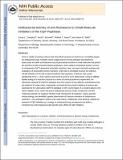Antibacterial Activity of and Resistance to Small Molecule Inhibitors of the ClpP Peptidase
Author(s)
Compton, Corey L.; Schmitz, Karl R.; Sello, Jason K.; Sauer, Robert T
DownloadSauer_Antibacterial activity.pdf (824.8Kb)
PUBLISHER_POLICY
Publisher Policy
Article is made available in accordance with the publisher's policy and may be subject to US copyright law. Please refer to the publisher's site for terms of use.
Terms of use
Metadata
Show full item recordAbstract
There is rapidly mounting evidence that intracellular proteases in bacteria are compelling targets for antibacterial drugs. Multiple reports suggest that the human pathogen Mycobacterium tuberculosis and other actinobacteria may be particularly sensitive to small molecules that perturb the activities of self-compartmentalized peptidases, which catalyze intracellular protein turnover as components of ATP-dependent proteolytic machines. Here, we report chemical syntheses and evaluations of structurally diverse β-lactones, which have a privileged structure for selective, suicide inhibition of the self-compartmentalized ClpP peptidase. β-Lactones with certain substituents on the α- and β-carbons were found to be toxic to M. tuberculosis. Using an affinity-labeled analogue of a bioactive β-lactone in a series of chemical proteomic experiments, we selectively captured the ClpP1P2 peptidase from live cultures of two different actinobacteria that are related to M. tuberculosis. Importantly, we found that the growth inhibitory β-lactones also inactivate the M. tuberculosis ClpP1P2 peptidase in vitro via formation of a covalent adduct at the ClpP2 catalytic serine. Given the potent antibacterial activity of these compounds and their medicinal potential, we sought to identify innate mechanisms of resistance. Using a genome mining strategy, we identified a genetic determinant of β-lactone resistance in Streptomyces coelicolor, a non-pathogenic relative of M. tuberculosis. Collectively, these findings validate the potential of ClpP inhibition as a strategy in antibacterial drug development and define a mechanism by which bacteria could resist the toxic effects of ClpP inhibitors.
Date issued
2013-09Department
Massachusetts Institute of Technology. Department of BiologyJournal
ACS Chemical Biology
Publisher
American Chemical Society (ACS)
Citation
Compton, Corey L., Karl R. Schmitz, Robert T. Sauer, and Jason K. Sello. “Antibacterial Activity of and Resistance to Small Molecule Inhibitors of the ClpP Peptidase.” ACS Chemical Biology 8, no. 12 (December 20, 2013): 2669–2677.
Version: Author's final manuscript
ISSN
1554-8929
1554-8937